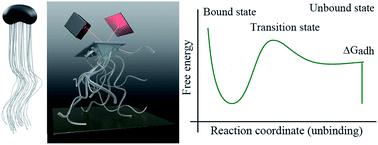当前位置:
X-MOL 学术
›
Nanoscale Adv.
›
论文详情
Our official English website, www.x-mol.net, welcomes your
feedback! (Note: you will need to create a separate account there.)
Mechanistic insight into biopolymer induced iron oxide mineralization through quantification of molecular bonding
Nanoscale Advances ( IF 4.6 ) Pub Date : 2020-06-15 , DOI: 10.1039/d0na00138d K K Sand 1, 2 , S Jelavić 3 , S Dobberschütz 3 , P D Ashby 2 , M J Marshall 4 , K Dideriksen 3 , S L S Stipp 3 , S N Kerisit 1 , R W Friddle 5 , J J DeYoreo 1, 6
Nanoscale Advances ( IF 4.6 ) Pub Date : 2020-06-15 , DOI: 10.1039/d0na00138d K K Sand 1, 2 , S Jelavić 3 , S Dobberschütz 3 , P D Ashby 2 , M J Marshall 4 , K Dideriksen 3 , S L S Stipp 3 , S N Kerisit 1 , R W Friddle 5 , J J DeYoreo 1, 6
Affiliation

|
Microbial production of iron (oxyhydr)oxides on polysaccharide rich biopolymers occurs on such a vast scale that it impacts the global iron cycle and has been responsible for major biogeochemical events. Yet the physiochemical controls these biopolymers exert on iron (oxyhydr)oxide formation are poorly understood. Here we used dynamic force spectroscopy to directly probe binding between complex, model and natural microbial polysaccharides and common iron (oxyhydr)oxides. Applying nucleation theory to our results demonstrates that if there is a strong attractive interaction between biopolymers and iron (oxyhydr)oxides, the biopolymers decrease the nucleation barriers, thus promoting mineral nucleation. These results are also supported by nucleation studies and density functional theory. Spectroscopic and thermogravimetric data provide insight into the subsequent growth dynamics and show that the degree and strength of water association with the polymers can explain the influence on iron (oxyhydr)oxide transformation rates. Combined, our results provide a mechanistic basis for understanding how polymer–mineral–water interactions alter iron (oxyhydr)oxides nucleation and growth dynamics and pave the way for an improved understanding of the consequences of polymer induced mineralization in natural systems.
中文翻译:

通过分子键的量化对生物聚合物诱导的氧化铁矿化的机理洞察
微生物在富含多糖的生物聚合物上产生铁(氢氧化物)氧化物的规模如此之大,以至于影响了全球铁循环,并导致了重大的生物地球化学事件。然而,这些生物聚合物对氧化铁(羟基)形成的物理化学控制却知之甚少。在这里,我们使用动态力光谱法直接探测复合物、模型和天然微生物多糖与常见的铁(羟基)氧化物之间的结合。将成核理论应用于我们的结果表明,如果生物聚合物和铁(氢氧化物)氧化物之间存在强烈的吸引力相互作用,则生物聚合物会降低成核势垒,从而促进矿物成核。这些结果也得到了成核研究和密度泛函理论的支持。光谱和热重数据提供了对随后生长动态的深入了解,并表明水与聚合物缔合的程度和强度可以解释对氧化铁 (氧氢) 转化率的影响。结合起来,我们的结果为理解聚合物-矿物-水相互作用如何改变铁(氧)氧化物成核和生长动力学提供了机械基础,并为更好地理解聚合物在自然系统中诱导矿化的后果铺平了道路。
更新日期:2020-08-11
中文翻译:

通过分子键的量化对生物聚合物诱导的氧化铁矿化的机理洞察
微生物在富含多糖的生物聚合物上产生铁(氢氧化物)氧化物的规模如此之大,以至于影响了全球铁循环,并导致了重大的生物地球化学事件。然而,这些生物聚合物对氧化铁(羟基)形成的物理化学控制却知之甚少。在这里,我们使用动态力光谱法直接探测复合物、模型和天然微生物多糖与常见的铁(羟基)氧化物之间的结合。将成核理论应用于我们的结果表明,如果生物聚合物和铁(氢氧化物)氧化物之间存在强烈的吸引力相互作用,则生物聚合物会降低成核势垒,从而促进矿物成核。这些结果也得到了成核研究和密度泛函理论的支持。光谱和热重数据提供了对随后生长动态的深入了解,并表明水与聚合物缔合的程度和强度可以解释对氧化铁 (氧氢) 转化率的影响。结合起来,我们的结果为理解聚合物-矿物-水相互作用如何改变铁(氧)氧化物成核和生长动力学提供了机械基础,并为更好地理解聚合物在自然系统中诱导矿化的后果铺平了道路。











































 京公网安备 11010802027423号
京公网安备 11010802027423号